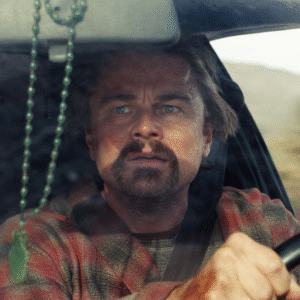Kaja, 16, and Alicja, 17, on why Paul Thomas Anderson’s venture into politics does not meet expectations


Leonardo DiCaprio in ‘One Battle After Another’ (2025), directed by Paul Thomas Anderson.
Picture by: LANDMARK MEDIA | Alamy
Article link copied.
November 21, 2025
Sean Penn steals the show while DiCaprio gets high. One Battle After Another review
Paul Thomas Anderson’s One Battle After Another is a slow-burning process of exploration of what is left after the battle ends. The movie, set in the aftermath of a failed revolution, tells a story of the wounds that never heal.
Bob (Leonardo DiCaprio), once a relentless revolutionist and now a single dad, drifts through life in a drug-induced haze. When the past he attempted to bury resurfaced and put his teenage daughter (Chase Infiniti) in danger, he is forced to confront the past – and himself.
Harbingers’ Weekly Brief
At first, it may seem that One Battle aims to target mainstream audiences, hungry for raw action and DiCaprio’s signature intensity. Yet, the film is also an attempt at a political satire, paralleling current American politics. Anderson aims to show the country rotting from within, where elites profit from chaos, and revolution is crushed under greed.
For long-time fans of Paul Anderson’s work, this film is quite a feast. It’s not only visually striking, but also explores the psychological themes the director is renowned for – father-daughter relationship, drug abuse, generational trauma.
However, the exploration of political ideas often feels uneven. With scenes of ICE raids and overcrowded migration camps, Anderson creates an unsettling picture: refugees stuck behind barbed wire; morally blind, cruel guards. The urgency of this image contrasts with the decision to abandon it, when no longer relevant to the plot – because of this, Anderson’s critique of American politics and society feels more like a costume, as he seems to have used the revolution as an aesthetic only.
This might be the only downside of the production. As a visual piece, One Battle… is worth every praise. The film was shot using unique VistaVision technology and the cinematography is breathtaking: dusty Californian valleys baked in the sun, flickering neon hideouts, beautiful open landscapes with majestic mountains shown in natural light and through wide-angle lenses. This creates such a staggering image that the film is worth seeing on the large screen. The score perfectly underlines the tension and becomes a part of the film’s rhythm, though it never seems overwhelming.
Leonardo DiCaprio delivers quite an unpredictable performance, channelling his haunted, chaotic energy while merging it with the slow-burning tone of the movie.
This role is loved by his fans, but the performance that caught the eye of the critics was Sean Penn’s role as Lockjaw. His acting is one of the most captivating elements of the movie – his voice, his walk and his characterisation together create a truly bewildering persona.
Viewers who admire Anderson’s famous films, such as Magnolia (1999), There Will Be Blood (2007) or The Master (2012), will be quite surprised to see how he ventures into the political action thriller genre – an unfamiliar manner for the director, though one that still bears a piece of his unique style. One Battle After Another may appear to be a radical departure from his previous work, yet it definitely continues his fascination with loneliness, disappointment and the chaos of human desire.
One Battle… replaces operatic coincidence with constant dynamic. The focused, calm camera work that contrasted with the vulnerability of those on screen in Magnolia, here is replaced by relentless action, as though camerawork and editing were dictated by the pulsating soundtrack from Jonny Greenwood. Yet beneath the surface, the film echoes Magnolia’s despair – people still search for meaning in a world of chaos, humour masks existential pain.
A comparison to Anderson’s two other films, There Will Be Blood and The Master, reveals another dimension of the director’s artistic evolution. Both are serious studies of power and belief, showing protagonists engulfed in obsession and moral decay, consumed by their ideologies.
His new film shifts this internal struggle into the public sphere, turning psychological conflict into literal warfare. Its modern setting transforms Anderson’s usual physical loneliness into political alienation, where action substitutes for reflection but never distracts from emptiness.
Ultimately, One Battle After Another reimagines Anderson’s repeating concerns, such as loneliness, faith and control, through this newly introduced cinematic mix of genres. The film is louder, faster and easier to grasp, but its roots stay with PTA.
Written by:

Writer
HRB Film & Book Club
Warsaw, Poland
Born in 2009 in Warsaw, Poland, Kaja joined Harbingers’ Magazine to write about and share the beauty of film, photography and literature.
Her plans for the future are to study international relationships, psychology in business, or working in film production – she aspires to progress in directions where she could be truly proud of what she is doing.
In her spare time she enjoys discovering and reviewing good films, reading philosophical books, designing art, cooking and baking. She likes to be active in any type of sport, mainly volleyball and snowboarding.

Writer
HRB Film & Book Club
Warsaw, Poland
Born in 2008, in Warsaw, Poland, Ala joined Harbingers’ Magazine, excited to write about books, movies, tv and music.
At school, she’s focused on studying history and literature, and aspirers to connect these subjects with her future studies in psychology, sociology or law.
In her free time, she enjoys spending time outside – catching up with friends – as well as inside, mostly reading and adding movies to her watchlist. She loves art, music, film and photography, and she always looks forward to being inspired by a meaningful conversation.
This article is a part of Harbingers’ Film & Book Club, an initiative of 18 students from 2SLO in Warsaw, Poland.

#image_title
Edited by:

🌍 Join the World's Youngest Newsroom—Create a Free Account
Sign up to save your favourite articles, get personalised recommendations, and stay informed about stories that Gen Z worldwide actually care about. Plus, subscribe to our newsletter for the latest stories delivered straight to your inbox. 📲
© 2025 The Oxford School for the Future



